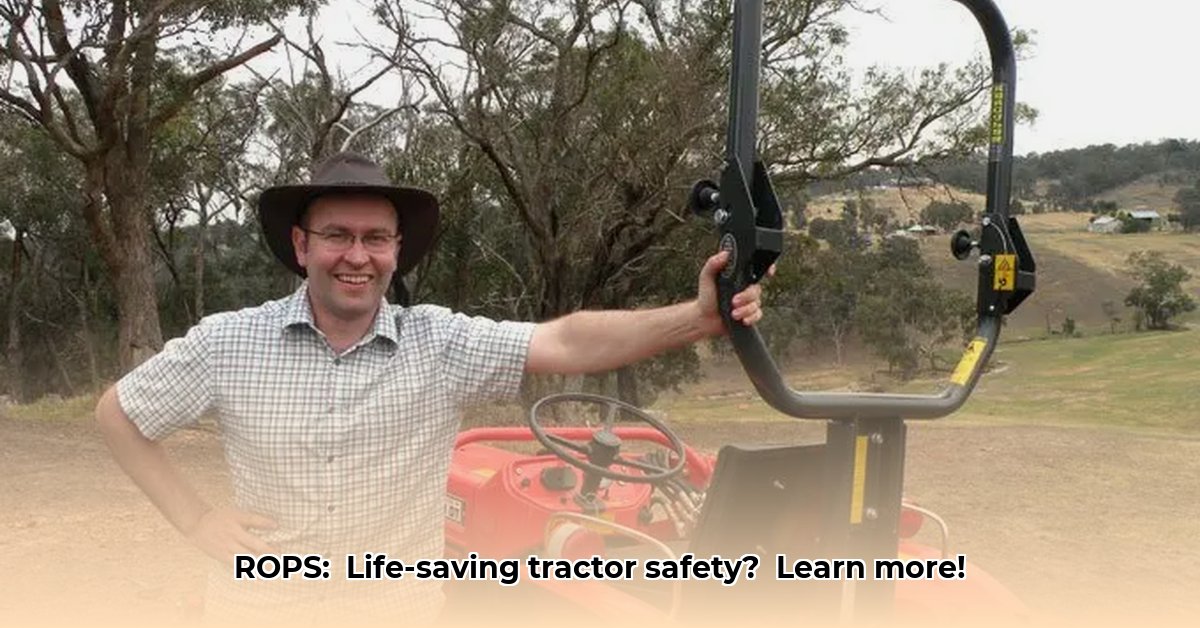
Understanding Tractor ROPS: Your First Line of Defense
Farming is demanding, and tractor rollovers pose a significant risk. A Rollover Protective Structure (ROPS) is your primary defense against serious injury or death in such an event. This essential safety feature is a sturdy frame designed to protect the operator during a rollover. Several types exist, including two-post, four-post, and fully enclosed cabs; each offers varying degrees of protection. The more robust the protection, the safer you are. For more information on ROPS safety, check out this helpful resource: ROPS safety guide.
Did you know that using a ROPS with a seatbelt dramatically reduces fatalities in tractor rollovers? This isn't just a statistic; it's a life-saving measure. Is the risk of not having one worth it?
Regularly Inspecting Your ROPS: A Few Minutes Can Save Your Life
Regular ROPS inspections are vital for maintaining its protective capabilities. Examine the structure carefully for any cracks, rust, or damage before each use. A compromised ROPS offers minimal protection, much like a cracked helmet. A few minutes of inspection could save your life.
Adding ROPS to Older Tractors: An Investment in Your Future
Many older tractors lack factory-installed ROPS. Retrofitting is often feasible, but never attempt a DIY installation. Improper installation is extremely dangerous, potentially rendering the ROPS ineffective and increasing the risk of injury. Always hire a qualified professional for a safe and effective installation.
Maintaining Your ROPS: Keeping it in Top Shape
Regular maintenance is critical. Check all bolts and connections for tightness and lubricate moving parts. Addressing damage promptly is essential; neglecting maintenance is a gamble you shouldn't take with your life.
Seatbelts: The Often-Forgotten Safety Partner
A ROPS is only as effective as its proper use. The seatbelt is your partner in this safety system. The ROPS provides the protective structure but the seatbelt keeps you securely inside during a rollover. Always wear your seatbelt while operating the tractor.
The True Cost of Neglect: More Than Just Money
The cost of a serious injury or fatality far outweighs any perceived savings from neglecting safety measures. Your health is priceless.
Addressing Your Concerns: Common Questions and Answers
Farmers often have questions about ROPS:
| Concern | Potential Solutions |
|---|---|
| High Cost of Retrofitting | Explore state and local government subsidies or grants. A cost-benefit analysis reveals the value of your life far exceeds any ROPS expense. |
| Difficulty of Installation | Hire a qualified agricultural mechanic. DIY installation is extremely dangerous. |
| ROPS Limitations | While ROPS significantly increases survival chances, it's not a guarantee. Always practice safe driving habits. |
How to Choose the Best Tractor ROPS Retrofit Kit
Key Takeaways:
- ROPS significantly reduces tractor-related fatalities and serious injuries when used with seatbelts.
- Many older tractors lack ROPS, creating a substantial safety hazard.
- Retrofitting ROPS is possible, but requires careful compatibility and cost considerations.
- Resources, like the Kentucky ROPS Guide, assist in finding suitable kits and suppliers.
- Farmers must assess retrofit suitability for their tractor models and consider financial implications.
Understanding Your Tractor's Needs
Before choosing a retrofit kit, identify your tractor's make, model, and year. ROPS kits aren't universal; compatibility is critical. Incorrect installation is dangerous. Consult your owner's manual or your local dealer.
Evaluating ROPS Retrofit Kits: A Step-by-Step Guide
Identify Compatible Kits: Use online resources like the Kentucky ROPS Guide (https://www.farmprogress.com/farming-equipment/online-guide-simplifies-rops-retrofit) to find kits for your tractor.
Check Materials and Construction: Ensure the kit is made from high-quality, durable steel meeting safety standards. Examine welds and connections.
Assess Installation: Consider your mechanical skills. Will you need professional help? Factor in professional installation costs if necessary.
Compare Pricing and Warranties: Compare prices and warranties from reputable suppliers. The cheapest option isn't always best.
Verify Safety Certifications: Ensure the kit meets or exceeds relevant safety standards (OSHA, ANSI, etc.).
Cost-Effectiveness Analysis: Retrofitting vs. Replacement
Retrofitting is an investment weighing costs against safety benefits. The cost of injury or death vastly exceeds the cost of a ROPS. Consider the long-term costs and the value of your life. Sometimes, buying a new tractor with integrated ROPS might be more cost-effective.
Beyond the Kit: Safety Best Practices
Always wear your seatbelt while operating your tractor; it must be correctly secured to the ROPS. Regularly inspect your ROPS for damage and repair or replace parts promptly. Safe tractor operation and maintenance reduce the likelihood of rollovers.